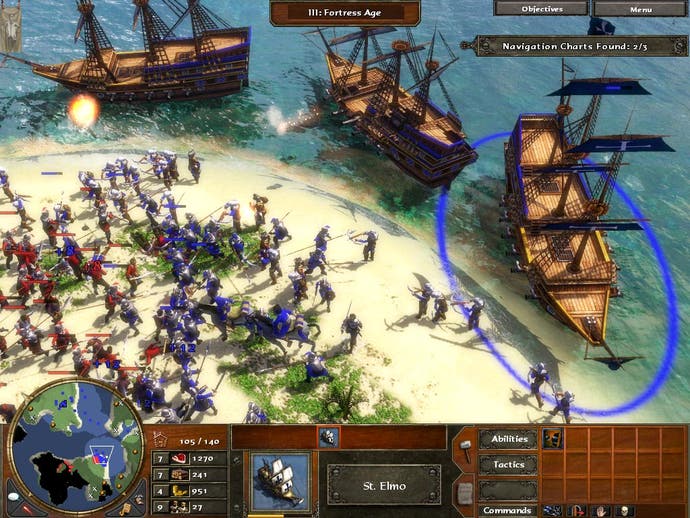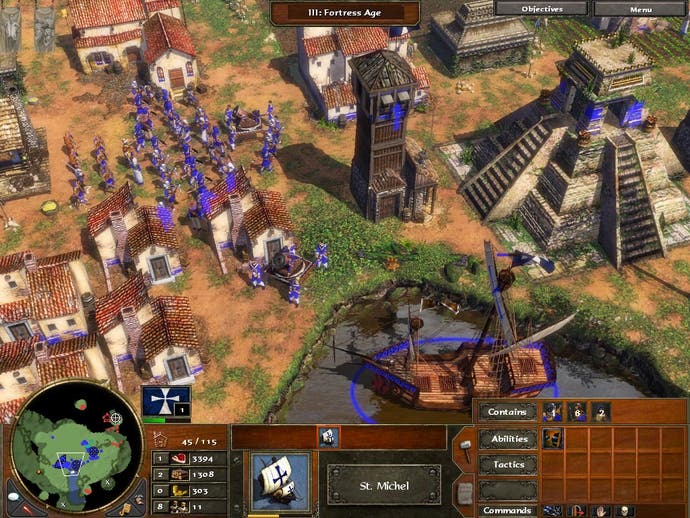Age of Empires III
New World, old gameplay.
There's something rather childish, cynical even, about Age of Empires III. Playing it I'm reminded of a girl at school that started giving me presents (chocolate mainly) on a daily basis. She was, I guess, trying to win my affection. Being confused (it was the first time I'd ever been actively pursued) and being greedy I took the bars for a couple of weeks before guiltily asking her to stop. Right now I feel like I want to say to AoE3 "Stop with the gifts! To win my heart you don't need to sprinkle every map with silly treasure troves. You don't need to let me flick to a 'home city' screen every few minutes so that I can select a free unit or resource windfall. I'm not some spoilt toddler that needs to be bribed with endless sweeties."
Somewhere along the line Ensemble seem to have lost sight of what's important in a real-time strategy game. AoE3 looks and sounds fantastic yet its economics are dull, its factions are bland, and its combat is crude and fiddly. Without the addition of that novel home city concept (more on which in a second) this would be a startlingly unoriginal creation.
Before I flesh-out those comments, pushing the critical bowie knife even deeper, here's some background and some basics. This is the fourth episode of one of the biggest strategy franchises around. Taking-up where Age of Kings - the second episode - left-off and ending where AoE4 will one day doubtless begin, it plunders the period between 1500 and 1850 for it's unit type and tech inspirations. The stage is the New World, the playable powers - eight squabbling European states supported by various indigenous tribes. Skirmish and multiplay fit the traditional 'gather, build, battle' pattern to a tee while the twenty-four episode sequential campaign, though well-written and imaginatively framed, offers exactly the same kind of challenges that RTS campaigns have been offering for years. Destroy that town, hit that resource threshold, hold-out for this many minutes... perhaps if there was a choice of hoops occasionally or they were little less obvious, then jumping through them would be more fun.

The closest thing to freshness here is that home city concept. Where other RTS developers all seem to be turning to strat maps to enrich their offerings Ensemble bravely try something quite different. In AoE3, whenever your troops slay or demolish, or your peons gather or construct, the activity generates RPG-style experience points for your home city - an attractive 3D diorama always just a key press away. The point of regularly returning to Istanbul, Lisbon, St Petersburg or wherever is, oddly enough, not to visit your Mum and get your laundry done, it’s to order shipments of new units, resources, and upgrades. Paid for with those XP points, deliveries take next to no time to cross the Atlantic to your settlement, and are never lost to pirates or stormy seas.
So the home city is just an awkward version of a standard market or barracks building then? No, it is slightly more interesting than that. Periodically your city levels-up and you get to choose new shipment types (called ‘cards‘). Because the cards are arranged in tech-tree fashion and cities are persistent - even in MP and skirmish modes - a choice you make on Monday has an effect in the game you play on Tuesday. Put simply, the more you play, the more shipment choices you get.

The positives with this system are fairly obvious. There’s a gratifying sense of progress whether you're romping through the campaign, sparring with the solid if predictable AI, or battling online. One of the negatives is that it discourages cultural infidelity. The player that diligently switches faction every game will get nowhere. Much better to stick with one power and watch them blossom over several weeks.
Staying monogamous has another advantage too. As cities level-up you don’t only get new cards, you get credits to spend on urban enhancements like flags, market stalls, and street performers. A bit like the Civ3 palace system these extras are just for show, another manifestation of that distracting ‘free gift’ culture decried in the first paragraph.
Ripping into AoE3 for its lack of realism would be unfair (it’s not pitched as a historical recreation after all) but personally I’d like to have seen a tad more engagement with the subject matter. As any Cossacks 2 player will tell you, combat during the Colonial era was all about formations, fear and flintlock reload times. Ensemble’s interpretation is all but identical to its interpretation of medieval warfare. Invariably scraps turn into chaotic scrums where the winner is the fellow with the biggest and buffest force, or the one that can replenish their side of the swarm most efficiently. Forget flanking, forget terrain, forget friendly fire, standard bearers and drummer boys. It’s a similar story on water. The new navy units are gorgeous but the way they move, attack and take damage would baffle Nelson.

Economics have undergone some streamlining since AoK. Resource types are down to three (no more stone) and peons no longer have to trudge to drop-off structures with their wood, meat or gold. Sensible steps but ones that underline just how stylised and generic this game‘s version of colonial history is. For the real settlers there were, of course, no gold mines, no markets where supply shortages could be instantly rectified. The game’s portrayal of the Amerindians is particularly bizarre. Never hostile, they function essentially as cheap mercenaries and experience generation devices. By building a trading post at a camp and surrendering some food you can supplement your armies with braves whenever the need arises. A unit that often ends-up constructing the posts is the new Explorer. Like a Warcraft or Age Of Mythology hero, he’s a one-off who, if slain can be automatically resurrected by nearby friendlies. When he’s isn’t waiting for reanimation he’s generally (if you’ve got any sense) dashing round the map dispersing the fog of war and grabbing the ridiculous number of treasure caches. Gold wagons surrounded by wild animals, xp-bestowing artifacts guarded by outlaws, indians dangling from bear-patrolled trees... wherever you wander on most of the region-themed maps there’s usually some tantalising prize waiting to be collected.
These hand-outs are symptomatic of the stagnation at the heart of Age of Empires 3. Even with the new home cities, gameplay feels tired and characterless. Bombarding players with shiny baubles and inconsequential gifts can’t hide that.







